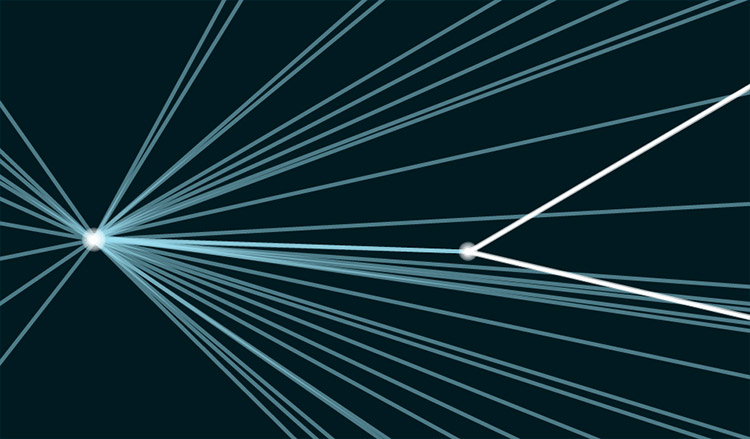Physicists Explain Puzzling Particle Collisions
A modification simplifies one piece of the standard mathematical model of particle physics
Published Date
By:
- Susan Brown
Share This:
Article Content

Composite subatomic structures created by powerful collisions of protons have fallen apart in unexpected ways within a detector in the Large Hadron Collider called LHCb.
The ‘b’ in the detector’s name stands for beauty, a designation for a kind of quark, one of the fundamental building blocks of matter. Pairs of quarks, a beauty quark plus another - any one of several different kinds - together make up a beauty meson.
Mesons are unstable, fleeting structures that quickly decay into elementary particles. One type of decay produces either an electron and a positron, or a muon and its anti-matter counterpart, an anti-muon.
The Standard Model of particle physics, a powerful mathematical model that has guided physicists to the discovery of the Higgs boson and other particles before it, predicts that the two outcomes will occur at equal rates.
But experiments using the LHCb detector see a skewed muon-to-electron decay ratio lower than expected by 25 percent. Anomalies of this kind point to “new physics,” details of the fundamental forces of nature that remain to be worked out.
Benjamin Grinstein, professor of physics at the University of California, San Diego, with postdoctoral fellows Rodrigo Alonso De Pablo and Jorge Martin Camalich reconsidered the mathematics that underlie the prediction. They published a revision this week in the journal Physical Review Letters.
The Standard Model describes the particles and their interactions, which create the fundamental forces of nature including electromagnetism and the “weak force,” which is responsible for radioactive decay.
In ordinary circumstances, the weak force and electromagnetism appear to be distinct, but under extraordinary conditions, such as the high energies produced by colliders or extreme condition of the cosmos moments after the Big Bang, they are thought to be unified, a notion called the electroweak theory.
“We noticed that the parameters people were using for experiments for low-mass particles like mesons were not incorporating constraints consistent with this extension — these modifications to the Standard Model that account for additional interactions,” Grinstein said. “When you do, you find surprisingly many restrictions. The thought was that at low energies you can forget about constraints from electroweak theory because you don’t see them, but that’s not true.”
When the two forces are considered as one, some of the mathematical terms that describe the interactions, called parameters, are not allowed and can be discarded, Grinstein’s group concluded. Others are related, and so can be collapsed into single parameters, greatly reducing the total number of parameters the model must consider.
“Usually a closer look leads to more detailed or complicated models. One of the nicest things about this project is that our assumptions remarkably simplified the study of the physics of these decays,” Alonso said.
“We were able to pin down the new physics to explain the anomaly,” Martin Camalich said.
Their description is entirely consistent with the mathematics of the Standard Model. It is an add-on that accounts for small deviations in the expected behavior of low mass particles, such as the way beauty, strange and charm mesons decay.
Their simplified mathematical description makes specific predictions about what experimental physicists should observe. It constrains the spin, or helicity, of the elementary particles produced by certain interactions, for example.
These are extremely rare events; just one in 100 million beauty mesons decay in this way, though the collider produces billions. Only this one detector has seen the anomaly Grinstein’s group considered.
Quantum field theory says that forces, or interactions, arise from the exchange of particles.
“This parametrization ignores the particle exchange. It’s agnostic about that,” Grinstein said. But it’s a potential guide for discovering new elementary particles. “Once the exchange is well described, you can go back to ask what kind of particle must mediate it with some very specific requirements.”
If additional particles exist, they have escaped notice thus far, perhaps because they are so massive that colliders haven’t yet reached the energies needed to produce them.
Cosmology points to undiscovered physics as well with the existence of dark matter made of a substance unknown and dark energy accelerating the expansion of the universe with an unaccounted for force. Mysteries could convene if new particles turn out to be the stuff of dark matter.
“In physics, if you keep asking questions you get to the fundamentals, the basic interactions that can explain everything else,” Alonso said.
This work was supported in part by the Department of Energy. Jorge Martin Camalich has received funding from the European Union’s Seventh Framework Program and support from Spain’s Ministry of Economics and Competitiveness and the EU’s European Regional Development Fund.
Share This:
You May Also Like
Stay in the Know
Keep up with all the latest from UC San Diego. Subscribe to the newsletter today.



